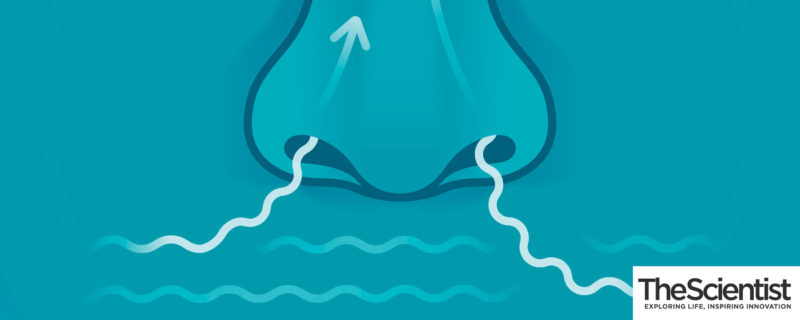







Fruity, woody, or minty! ‘Digital smells’ sent via electrodes placed inside your nose could let you transmit ODOURS in messaging and dating apps
‘It is part of a whole, integrated virtual reality or augmented reality’, lead researcher Adrian Cheok who is the director of the Imagineering Institute in Malaysia told NBC.
‘So, for example, you could have a virtual dinner with your friend through the internet. You can see them in 3D and also share a glass of wine together’, he said.
Researchers created ten different odours for the 31 participants involved in the research.
Dr Cheok believes that one day odours will be sent in digital form over the internet – although he says that it might still be decades away.
The recipient could receive them by wearing glasses or goggles with electrodes in them.
‘The next stage is to produce it in a more controlled manner, and this will allow for people to develop software and products to generate electric smell’, Dr Cheok says.
He believes it could also restore smell to people who have lost it due to illness or an accident.
However, critics say that smells might not have been created by electricity.
Joel Mainland, a neuroscientist at the Monell Chemical Senses Centre told NBC that although it could be possible to create odours using electrical stimulation that might not have happened in this study.
‘If you are asking someone if something smells, they have a strong bias to say yes even where there is no odor’, he said.

Earlier this week, scientists said that zapping the brain by placing electrodes inside the nostrils could bring back someone’s lost sense of smell.
Being able to regain smell would be a breakthrough for millions, as figures estimate up to five per cent of people are unable to process scents.
Doctors at Massachusetts Eye and Ear tested the method on five patients who could already smell. It is the first time the sense has been stimulated this way.
The scientists believe the results open the door for a cochlear implant for the nose.
By placing electrodes in the nose, the nerves in the olfactory bulb were stimulated, and information was sent to the deeper regions of the brain.
Some cases of loss of smell can be treated by caring for an underlying cause, such as blocked sinuses or swelling, where the nasal passage is obstructed and smells can’t reach the brain.
In more complicated cases, the sensory nose may be damaged due to head injury, a virus or ageing, which can lead to anosmia – complete loss of smell.
There are currently no proven therapies for this, but the study proves there are options on the horizon.


By Chris Mahon, Wednesday, 28 November 2018 – 1:53PM
Of all the useless projects undertaken by humanity, few have been more difficult, futile, and unpleasant than artificially creating smell, either through electrical impulses or by pumping in smells directly into a room (like the ill-fated Smell-O-Vision). Though smells can trigger emotions and even memories, nobody is really clamoring for a piece of technology that lets you smell someone you’re video-chatting with or sample a catalog of virtual smells (unless it’s one of those fancy air fresheners). Nevertheless, a team of researchers in Malaysia is forging ahead with digital smell technology, and they claim to have made some progress.
During the experiments, 31 participants had an electrodes inserted in their nostrils, which stimulated the receptors in the nose that send signals to the brain to create a sensation of smell. According to the Imagineering Institute, which conducted the study, the researchers were able to evoke 10 different artificial scents, though they weren’t able to control which one the participants smelled.
According to Adrian Cheok, one of the researchers associated with the study: “It’s not just about the smell. It is part of a whole, integrated virtual reality or augmented reality. So, for example, you could have a virtual dinner with your friend through the internet. You can see them in 3D and also share a glass of wine together.”
However, some scientists have doubted the findings of the study. One of them is Charles Spence, of the University of Oxford, who told Mach: “Any everyday smell will probably activate tens or hundreds of receptors. If you have only got one electrode in the nose, no matter what frequency rate or intensity (of electrical current you use) you are not going to be able to stimulate enough receptors to deliver a (perception).”
Joel Mainland, of Monell Chemical Senses Center in the United States, also pointed out that people may believe they can smell a faint odor when they’re told they should be smelling one. According to Mainland, the Malaysia study doesn’t adequately account for this issue.
Either way, we’re not holding our breath (or noses) for the day when you can email someone the scent of a sandwich.

Researchers envision a cochlear implant–like device for the nose to give people with impaired olfaction a sense of smell.
“Our work shows that smell restoration technology is an idea worth studying further,” says coauthor Eric Holbrook of Massachusetts Eye and Ear Infirmary in a press release. “The development of cochlear implants, for example, didn’t really accelerate until someone placed an electrode in the cochlea of a patient and found that the patient heard a frequency of some type.”
Holbrook and colleagues enrolled five subjects in the study who were able to smell. Three of them reported perceiving odors not actually present when the researchers stimulated different parts of their olfactory bulbs with electrodes inserted through the nose, a procedure the study authors say caused “minimal discomfort.” Subjects described the smells as “onion-like,” “antiseptic-like,” “sour,” “fruity,” or simply “bad.”
The finding follows a report earlier this year that electrically stimulating structures high up in the nasal cavity produced smell sensations. The scientists who conducted that study at Malaysia’s Imagineering Institute aim to one day transmit smells electronically, reportes IEEE Spectrum—for example, to give restaurant-goers a whiff of dishes on the menu as they decide what to order.
As in the Massachusetts Ear and Eye study, the Imagineering Institute researchers weren’t able to control which odor the subjects perceived. The Malaysian team suggests the digital smells could be transmitted through a noninvasive headset, rather than with electrodes up the nose, which their volunteers found quite uncomfortable. As coauthor Kasun Karunanayaka tells IEEE Spectrum, “A lot of people wanted to participate, but after one trial they left, because they couldn’t bear it.”